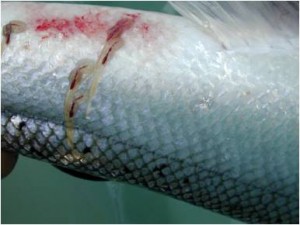Scotland’s salmon sea lice crisis
Scotland is the third largest farmed Atlantic salmon producer after Norway and Chile1. Its salmon sea lice crisis (SSLC)

concerns the infestation of farmed salmon with the sea louse parasite. This occurs during the saltwater stage of the multi-stage salmon lifecycle that aquaculture imitates. Naturally, predation on sea lice and infected salmon, and low salmon population densities, keep sea lice numbers low; high stocking densities in salmon farming attract sea lice2. They flourish by feeding on salmon skin and mucous. The SSLC economic and environmental costs receive considerable attention, but what are the animal welfare costs?
Welfare issues
Most scientists agree that fish are sentient. The precursor of the SSLC—high stocking densities—is itself a welfare issue. Salmon are a carnivorous and migratory species, motivated to hunt and swim thousands of miles in spacious oceanic conditions3. Typical farms enclose approximately 70,000 salmon per 40m-wide pen4, severely limiting their natural behaviour. This can then lead to physical health issues, increased aggression and enhanced intragroup disease transmission2.

Sea lice can cause significant wounds and stress5,6. This compromises salmon’s quality of life, physical health and immune system, leading to secondary infections and potentially death6. Other welfare issues (e.g., stressful husbandry practices) also weaken their immune system, further increasing their susceptibility to the negative effects of parasites5,6.
Attempts at mitigating the SSLC create additional welfare issues. Despite calls to ban chemicals such as emamectin, fisheries are using increasingly toxic treatments in sky-rocketing quantities to counter emerging sea lice resistance, causing thousands of farmed and wild fish mortalities7. Some fisheries are adopting ‘cleaner fish’ (e.g., wrasse) who eat sea lice; however, Loch Duart farm’s sea lice numbers soar above acceptable levels despite its zealous use of wrasse, suggesting this method is also unreliable8. This method raises other welfare and ethical issues concerning the farming or wild capture of cleaner fish, and their co-habitation with salmon2. To dislodge sea lice, fish may also be submerged into heated water, which has caused numerous mortalities.
Sea lice disperse into the ocean and infect wild salmonids (e.g., salmon and trout) whose migratory routes pass fisheries9. Escaped farmed salmon further spread sea lice to wild salmonids.
Current situation and solutions
In June 2017, over 61% of Scottish salmon farms failed to meet the industry’s recommended threshold of one louse per salmon10. SSLC-induced mortality rates also continue to rise11. Yet the government is neither intervening nor readily sharing sea lice data. After significant pressure from Salmon & Trout Conservation Scotland, a government inquiry into the industry is due in early 201812. Closed sea cages appear the best solution to minimise harm to wild fish and the environment, yet this will not in itself safeguard farmed salmon welfare. Additional regulation is necessary to honour the inclusion of farmed fish within the Animal Welfare Act 200613. Arguably, aquaculture will always remain unethical if alternative means of economical input, jobs and nourishment are possible.
Summary and how you can help
Scotland’s SSLC is only worsening. Welfare compromises in farming salmon cause and result from the SSLC. Wild salmonid welfare is heavily impacted too. The RSPCA-assured label is highly controversial, so we cannot necessarily trust this putative high-welfare label. You can help by boycotting the worst-offending companies. For the greatest contribution, shift to a plant-based diet.
References
- FAWC (2014). Opinion on the Welfare of Farmed Fish. Available at: https://www.gov.uk/government/uploads/system/uploads/attachment_data/file/319323/Opinion_on_the_welfare_of_farmed_fish.pdf [accessed 04 Dec. 2017].
- Compassion in World Farming (2008). Compassion in World Farming Briefing: Welfare of Farmed Fish. Available at: https://www.ciwf.org.uk/media/3818654/farmed-fish-briefing.pdf [accessed 04 Dec. 2017].
- Shearer, W.M. (1992). The Atlantic Salmon: Natural History, Exploitation and Future Management. Oxford, UK: Fishing News Books.
- Paxman, J. (2017). The terrible cost of Scottish salmon farms. Financial Times. 11 August, 2017. Available at: https://www.ft.com/content/8b73e21a-7cf8-11e7-ab01-a13271d1ee9c [accessed 03 Dec. 2017].
- Ashley, P.J. (2007). Fish welfare: Current issues in aquaculture. Applied Animal Behaviour Science. 104 (3-4). 199-235.
- Nolan, D.T., Reilly, P. and Wendelaar Bonga, S.E. (2011). Infection with low numbers of the sea louse Lepeophtheirus salmonis induces stress-related effects in postsmolt Atlantic salmon (Salmo salar). Canadian Journal of Fisheries and Aquatic Sciences. 56 (6). 947-959.
- The Global Alliance Against Industrial Agriculture (2017). Sky-rocketing chemical use on Scottish salmon farms – Hydrogen peroxide use leaps from 19,000 litres in 2005 to 19m litres in 2015. 12 February, 2017. Available at: http://donstaniford.typepad.com/files/pr-hydrogen-peroxide-skyrocketing-use-feb-2017.pdf [accessed 07 Dec. 2017].
- Salmon & Trout Conservation UK (2016). Complaint to the Commission of the European Communities. Available at: https://www.salmon-trout.org/wp-content/uploads/2017/09/STC_complaint_to_European_Commission_May_2016.pdf [accessed 07 Dec. 2017].
- Salmon & Trout Conservation Scotland (2015). The Control of Sea Lice on Fish Farms in Scotland 2013-2015. Available at: https://www.salmon-trout.org/wp-content/uploads/2017/08/STC-Scotland-2013-2015-The-Control-of-Sea-Lice-on-Fish-Farms-in-Scotland.pdf
- Salmon & Trout Conservation Scotland (2017). Data reveals astonishingly high sea lice levels, Scottish Government regulation of salmon farms shown to be wholly inadequate. Available at: https://www.salmon-trout.org/2017/10/30/scotish-salmon-farmings-liciest-farms-named-and-shamed/ [accessed 03 Dec. 2017].
- Salmon & Trout Conservation Scotland (2017). RSPCA Assured certification of Scottish farmed salmon: A report for Salmon & Trout Conservation Scotland. Available at: https://www.salmon-trout.org/wp-content/uploads/2017/09/RSPCA_Assured_report_2017_FINAL.pdf [accessed 04 Dec. 2017].
- The Scottish Parliament (2017). Official Report: Rural Economy and Connectivity Committee. Available at: http://www.parliament.scot/parliamentarybusiness/report.aspx?r=11034&mode=pdf [accessed 05 Dec. 2017].
- FAWEC (2015). The Future of EU Legislation on Farm Animal Welfare. Available at: https://www.youtube.com/watch?v=kT4PyOZkUa8 [accessed 03 Dec. 2017].
Images
a) Dixon, D. (2017). Salmon Farm near Goirtean a’ Chladaich [digital image]. Distributed under a CC-BY 2.0 license. Retrieved from: http://www.geograph.org.uk/photo/5470510 [accessed 02 Dec. 2017].
b) 7Barrym0re (2003). Sea Lice on Salmon [digital image]. Available to the public domain. Retrieved from: https://commons.wikimedia.org/wiki/File:Sea_lice_on_salmon.jpg [accessed 02 Dec. 2017].
